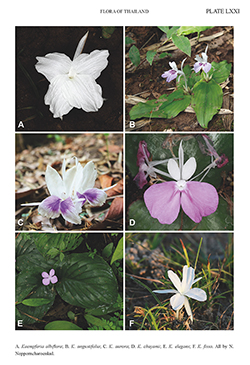e-Flora of Thailand
Volume 16 > Part 2 > Year 2023 > Page 617 > Zingiberaceae > Kaempferia
6. Kaempferia elegans Wall.wfo-0000451645
Pl. Asiat. Rar.: 1(2): 24, t.27. 1830; Fl. Brit. India 6: 222. 1890; Schumann, Pflanzenr. IV, 46 (Heft 20): 82. 1904; Ridl., Fl. Malay Penins. 4: 245. 1924; Henderson, J. Malayan Branch Roy. Asiat. Soc 17: 80. 1939; Holttum, Gard. Bull. Singapore 13: 123. 1950; Chin, Gard. Bull. Singapore 36(1): 75. 1983; Sirirugsa, Nordic J. Bot. 9: 259. 1989; Sirirugsa, Thai Forest Bull., Bot. 19: 5. 1991; Searle, Telopea 8(3): 375. 1999; Kress et al., Contr. U.S. Natl. Herb. 45: 122. 2003; Newman et al., Blumea, Suppl. 16: 119. 2004; Picheans. & Koonterm, J. Thai Trad. Alt. Med. 6(1): 77. 2008.— Monolophus elegans (Wall.) Horan., Prodr. Monogr. Scitam.: 22. 1862. Fig. 31, Plate LXXI: E.
Accepted Name : This is currently accepted.
Synonyms & Citations :
Description : Perennial herb, 10–48 cm tall; rhizome moniliform, globose, ca 1 by 1 cm, with fibrous roots bearing globose tubers. Bladeless sheaths 1–2, apex acute, red with green bands and green margin; ligule bilobed-truncate, petiole subsessile to 5 cm long, green or green with purplish red spots. Leaves 1–2, erect; blades elliptic, 13–27 by 8–15.5 cm, margin slightly undulate, midrib slightly grooved, finely sparsely appressed pilose, green above, pale green below, base subcordate, apex acute; petiole keeled, 4.5–20 cm long, appressed pilose, green with dull red bands near margin. Inflorescence terminal; peduncle to 2.1 cm long, scattered pilose; bracts lanceolate to linear lanceolate, 4–6 by 1–1.5 cm, apex acute, dull red with green spots, glabrous; bracteoles free, linear to narrow lanceolate, membranous, white, glabrous. Flowers 25–30; floral plane flat; pistil ca 6.5 cm long; ovary oblong, ca 5 by 4 mm, white, glabrous; style ca 6 cm long; stigma cup-shaped, 1.2–1.5 mm, margin ciliate, dark purple; epigynous glands linear, ca 3.5 mm long, pale yellow; calyx 2–2.7 cm long, split 1–1.3 cm on one side, apex acute, sparsely pilose, white, glabrous; floral tube 6–6.5 by 0.2–0.2 cm, white, glabrous, dorsal corolla lobe lanceolate, ca 2.4 by 0.6 cm, apex with long hood, 3.5–4 mm long, white, glabrous, lateral corolla lobes lanceolate, ca 2 by 0.5 cm, apex acute, white, glabrous; lateral staminodes suborbicular, ca 2 by 2 cm, apex acute to rounded, purple; labellum obconical, ca 2.5 by 2.8 cm, apex bilobed, divided by two-thirds of labellum length, each lobe circular, triangular, or suborbicular, 1.7 by 1.4 cm, apex truncate to rounded, purplish pink, white at base, dull at junction between colours; stamen attached to corolla lobe; filament sessile; anther thecae ca 4 by 1 mm, anther crest circular, ca 1 by 0.6 cm, reflexed to press on lateral staminodes at base, purplish pink with white base. Fruits ellipsoid, white; seeds obovoid, brownish yellow, aril white.
Thailand : Widespread.
Distribution : China, Laos, Myanmar (lecto).
Ecology : Deciduous forests, near waterfalls and along roads, bamboo forests, orchards. Flowering: March–July.
Vernacular : Pro (เปราะ), kambang phai (กำ บังภัย), suea sam thung (เสือสามทุ่ง), nok khum (นกคุ้ม).
Uses: Ornamental plant.
Notes: This species is distinct by its red stigma. The petiole can be subsessile to 25 cm long and the leaves to 1 m long with a great deal of variation in colour, green to reddish brown, with or without silver variegation.
Some populations with white flowers are found in Uthai Thani Province. The leaves are variable in size, shape and colour variegation. The delicate peduncle, the circular, reflexed anther crest and dark purple stigma are remarkable.


